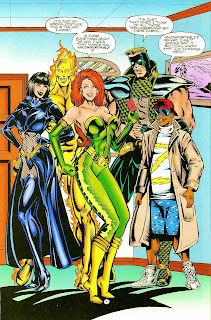Not only was The Strangers one of the three initial publications in the Ultraverse, it could said to be the central text. This series begins with the inciting incident that kicks off the entire universe, even though there is info on events happening prior to that incident in the first issue of Hardcase.
...and I think it might also be a reaction from Steve Englehart to the troubles he experienced in his second tenure at Marvel Comics, which saw one of his books taken away from him abruptly, another book taken away from him before he even began on it, and a third being so interfered with by editorial that he ultimately ended up writing the last few issues under the name 'John Harkness.' And it might explain why The Strangers abruptly ends as the Ultraverse is firmly under Marvel control.
Really abruptly. I mean, the last issue has a 'next issue' caption and covers for the next three issues printed alongside goodbye messages from Englehart and artist Rock Hoberg!A blast of light? Energy? from the moon hits a cable car in San Francisco full of passengers. Six of the passengers gain super powers, and start investigating first the mysterious magical woman who shows up at the accident site, then whether the other passengers have been similarly changed. Since one of the 'strangers,' a Latina fashion designer who now has a sort of aiming/homing sense, has resources and connections, she forms the group into a marketable Ultra Group...emphasis on the marketing.
I never read The Strangers when it was coming out, although their images were plastered prominently on those Ultraverse subway posters. Back then, unaware of the editorial problems that plagued Englehart over at Marvel, I assumed that it was going to be severely lacking. Visiting it now and I was really shocked at how much fun I had with this title...even though I sincerely winced at some of the character's codenames. Just like with Night Man, the nuts and bolts of living the superhero lifestyle plays a part in the title, but what really is refreshing is how character driven the narrative is.
And make no mistake--the characters are the strength, as Englehart takes what on the surface are stock types and gives them interesting new angles via interacting with each other and other heroes in the Ultraverse. Just look at Grenade, who is introduced as a stereotypical meatheaded jock who naturally gravitates to the hottest woman (kinda...she's actually a custom-made sexbot that gained sentience and electrical powers from the jumpstart and is now having a ball with being alive)...and yet shows true affection towards her and grief over what happens to his best friend. There's also Zip-Zap, who looks on the outside to be a kid that's been beaten down by the streets...and yet is very perceptive, is proud of how he comes up with new stunts with his super-speed, and creates a genuine bond with another member that draws her out of her shell. These are genuine narrative hooks in all of these stereotypical types that drive the title in interesting and intriguing direction, while also providing some nice story beats for the Ultraverse in general. Seeing the one gay character discussing sexual identity with Mantra during a crossover may be one of my favorite moments in the whole line so far.The book is broken into two major arcs, with a third arc kind of cut off mid-stream by the book's cancellation. The first, where our heroes explore their origins, is episodic but tons of fun, especially in regard to the character interactions. The second arc, 'The Pilgrim Conundrum,' has its moments (issue #13, introducing Powerhouse, a Superman analog who got his powers back during the Golden Age and was promptly sent to an insane asylum for bragging about his abilities, is amusing and issue #17's encounter with Rafferty are both standouts)...but I can't help feeling that the big resolution in issue #18 was a rather big letdown, even if Englehart planted all the clues in the issues leading up to it. Englehart was still in the middle of putting his third act in motion starting with issue #21, but considering it involved a character called Taboo that skirted being a racial stereotype joining enemy super-team TNTNT, it wasn't off to a good start.Art through the first 19 issues and both the Annual and the Night Man Annual it crossed over with was by Rick Hoberg. I first encountered Hoberg in the 70's when he was providing pencils on both Ms. Marvel and Savage She-Hulk and wrote him off as a mediocre artist...but man, did he improve by the time he started working on this title. Throughout his tenure, his work is fluid, dynamic and a lot of fun. And he manages to pull off some nice moments for these character beats Englehart loves.
Strangers is simply fun. None of the edgelord stuff that sometimes interferes with my enjoyment of other titles. An emphasis on character interaction. Fun set pieces. These all work to give me a fluid, consistent and high energy read even with the less-than-vibrant bad guys that sometimes mar the show. It's a real shame that this title didn't get at least a second volume, because it emphasized what the company insisted the line was all about. At the very least, they should have let those three issues get published as a miniseries.
Now granted, Englehart did try to put together another Strangers series, but we're going to get to that after we finish looking at all the titles. Next time, we'll be looking at the last super-group before we cover the Ultraverse super group as James Hundall puts corporate intrigue, magic, other dimensions, and some perviness into a blender to come up with The Solution!
Until then....why be meta when you can be ultra?









You are confusing Rick Hoberg with Mike Vosburg. Vosburg did the art for She-Hulk and Ms. Marvel.
ReplyDeleteI am enjoying your Ultraverse overview, by the way.